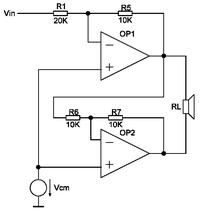TomasPitak
Newbie level 3
Hi,
how to test stability of bridged amplifiers?
Normally I'm using Middlebrook's method but I can't use it to test attached circuit. I can test only each amplifier. From one previous project I know that stability of this circuit is worst then of one voltage follower connected operational amplifier.
Any ideas? Thanks.

how to test stability of bridged amplifiers?
Normally I'm using Middlebrook's method but I can't use it to test attached circuit. I can test only each amplifier. From one previous project I know that stability of this circuit is worst then of one voltage follower connected operational amplifier.
Any ideas? Thanks.
